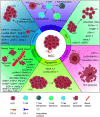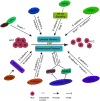Roles and Molecular Mechanisms of Biomarkers in Hepatocellular Carcinoma with Microvascular Invasion: A Review
- PMID: 37577231
- PMCID: PMC10412705
- DOI: 10.14218/JCTH.2022.00013S
Roles and Molecular Mechanisms of Biomarkers in Hepatocellular Carcinoma with Microvascular Invasion: A Review
Abstract
Hepatocellular carcinoma (HCC) being a leading cause of cancer-related death, has high associated mortality and recurrence rates. It has been of great necessity and urgency to find effective HCC diagnosis and treatment measures. Studies have shown that microvascular invasion (MVI) is an independent risk factor for poor prognosis after hepatectomy. The abnormal expression of biomacromolecules such as circ-RNAs, lncRNAs, STIP1, and PD-L1 in HCC patients is strongly correlated with MVI. Deregulation of several markers mentioned in this review affects the proliferation, invasion, metastasis, EMT, and anti-apoptotic processes of HCC cells through multiple complex mechanisms. Therefore, these biomarkers may have an important clinical role and serve as promising interventional targets for HCC. In this review, we provide a comprehensive overview on the functions and regulatory mechanisms of MVI-related biomarkers in HCC.
Keywords: Biomarkers; Hepatocellular carcinoma; Microvascular invasion; Molecular mechanism; Progress.
© 2023 Authors.
Conflict of interest statement
JWPY has been an editorial board member of Journal of Clinical and Translational Hepatology since 2021. The other authors have no conflict of interests related to this publication.
Figures


Similar articles
-
Upregulation of a novel LncRNA AC104958.2 stabilized by PCBP2 promotes proliferation and microvascular invasion in hepatocellular carcinoma.Exp Cell Res. 2021 Oct 1;407(1):112791. doi: 10.1016/j.yexcr.2021.112791. Epub 2021 Aug 18. Exp Cell Res. 2021. PMID: 34418457
-
Accurate prediction of microvascular invasion occurrence and effective prognostic estimation for patients with hepatocellular carcinoma after radical surgical treatment.World J Surg Oncol. 2022 Sep 30;20(1):328. doi: 10.1186/s12957-022-02792-y. World J Surg Oncol. 2022. PMID: 36180867 Free PMC article.
-
Microvascular invasion and positive HB e antigen are associated with poorer survival after hepatectomy of early hepatocellular carcinoma: A retrospective cohort study.Clin Res Hepatol Gastroenterol. 2018 Sep;42(4):330-338. doi: 10.1016/j.clinre.2018.02.003. Epub 2018 Mar 16. Clin Res Hepatol Gastroenterol. 2018. PMID: 29551612
-
Circulating tumor cells participate in the formation of microvascular invasion and impact on clinical outcomes in hepatocellular carcinoma.Front Genet. 2023 Nov 2;14:1265866. doi: 10.3389/fgene.2023.1265866. eCollection 2023. Front Genet. 2023. PMID: 38028589 Free PMC article. Review.
-
Significance of presence of microvascular invasion in specimens obtained after surgical treatment of hepatocellular carcinoma.J Gastroenterol Hepatol. 2018 Feb;33(2):347-354. doi: 10.1111/jgh.13843. J Gastroenterol Hepatol. 2018. PMID: 28589639 Review.
Cited by
-
Systematic Analysis of Disulfidptosis-Related lncRNAs in Hepatocellular Carcinoma with Vascular Invasion Revealed That AC131009.1 Can Promote HCC Invasion and Metastasis through Epithelial-Mesenchymal Transition.ACS Omega. 2024 Dec 3;9(50):49986-49999. doi: 10.1021/acsomega.4c09411. eCollection 2024 Dec 17. ACS Omega. 2024. PMID: 39713637 Free PMC article.
-
Spatial‒temporal heterogeneities of liver cancer and the discovery of the invasive zone.Clin Transl Med. 2025 Feb;15(2):e70224. doi: 10.1002/ctm2.70224. Clin Transl Med. 2025. PMID: 39924620 Free PMC article. Review.
-
A Grading System of Microvascular Invasion for Patients with Hepatocellular Carcinoma Undergoing Liver Resection with Curative Intent: A Multicenter Study.J Hepatocell Carcinoma. 2024 Jan 24;11:191-206. doi: 10.2147/JHC.S447731. eCollection 2024. J Hepatocell Carcinoma. 2024. PMID: 38283692 Free PMC article.
-
Portal vein tumor thrombosis in hepatocellular carcinoma patients: Is it the end?Liver Res. 2024 Sep 7;8(3):141-151. doi: 10.1016/j.livres.2024.09.002. eCollection 2024 Sep. Liver Res. 2024. PMID: 39957750 Free PMC article. Review.
-
Long non-coding RNA H19 promotes cervical cancer development via targeting the microRNA-140/ALDH1A1 axis.Eur J Med Res. 2025 Feb 12;30(1):95. doi: 10.1186/s40001-025-02350-8. Eur J Med Res. 2025. PMID: 39940029 Free PMC article.
References
Publication types
LinkOut - more resources
Full Text Sources
Research Materials
Miscellaneous
